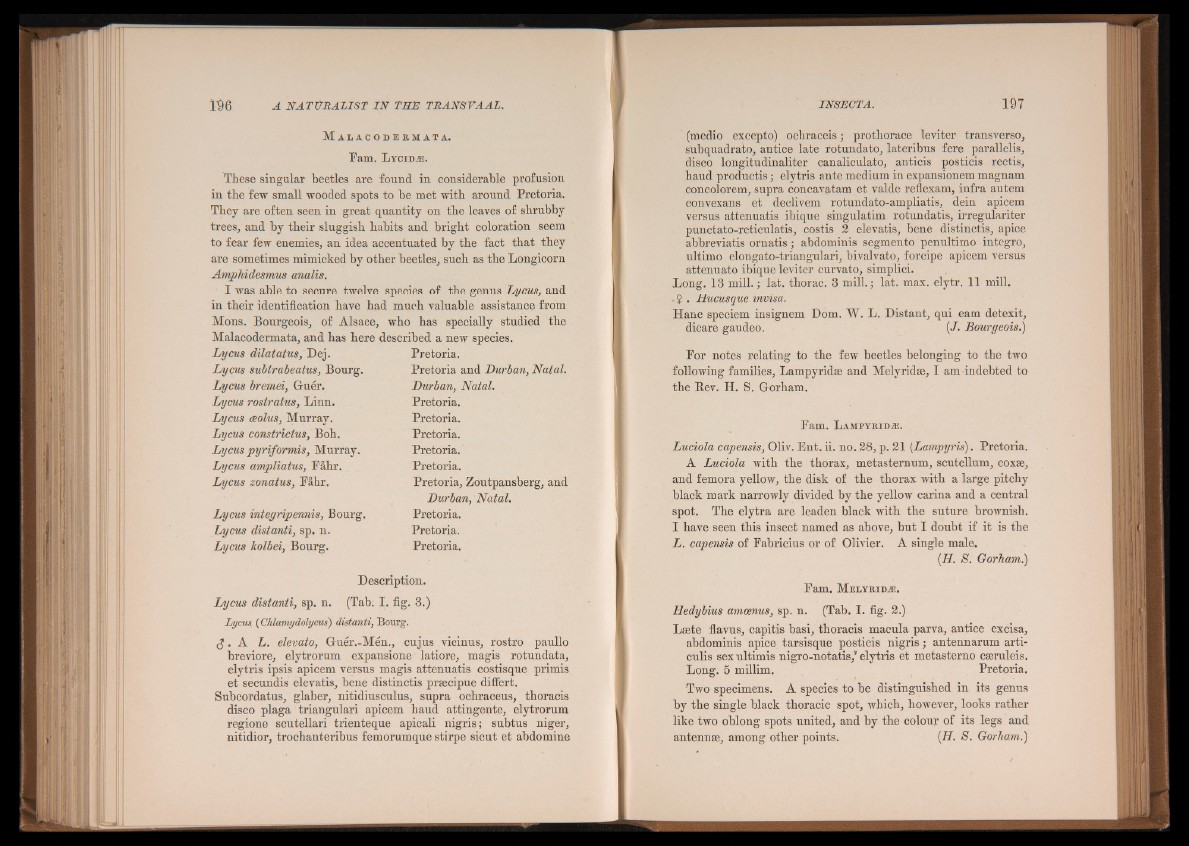
M a l a c o d e r m a t a .
Fam. Lycidae.
These singular beetles are found in considerable profusion
in the few small wooded spots to be met with around Pretoria.
They are often seen in great quantity on the leaves of shrubby
trees, and by their sluggish habits and bright coloration seem
to fear few enemies, an idea accentuated by the fact that they
are sometimes mimicked by other beetles, such as the Longicorn
Amphidesmus analis.
I was able to secure twelve species of the genus Lycus, and
in their identification have had much valuable assistance from
Mons. Bourgeois, of Alsace, who has specially studied the
Malacodermata, and has here described a new species.
Pretoria.
Pretoria and Durban, Natal.
Durban, Natal.
Pretoria.
Pretoria.
Pretoria.
Pretoria.
Pretoria.
Pretoria, Zoutpansberg, and
Durban, Natal.
Pretoria.
Pretoria.
Pretoria.
Lycus dilatatus, Dej.
Lycus subtrabeatus, Bourg.
Lycus bremei, Guér.
Lycus rostratus, Linn.
Lycus oeolus, Murray.
Lycus constrictus, Boh.
Lycus pyrifor mis, Murray.
Lycus ampliatus, Pâhr.
Lycus zonatus, Pâhr.
Lycus integripennis, Bourg.
Lycus distanti, sp. n.
Lycus kolbei, Bourg.
Description.
Lycus distanti, sp. n. (Tab. I. fig. 3.)
Lycus ( Chlamydolycus) distanti, Bourg.
J . A L. elevato, Guér.-Mén., cujus vicinus, rostro paullo
breviore, elytrorum espansione latiore, magis rotundata,
elytris ipsis apicem versus magis attenuatis costisque primis
et secundis elevatis, bene distinctis prsecipue differì.
Subcordatus, glaber, nitidiusculus, supra ochraceus, thoracis
disco plaga triangulari apicem haud attingente, elytrorum
regione scutellari trienteque apicali nigris; subtus niger,
nitidior, trochanteribus femorumque stirpe sicut et abdomine
(medio excepto) ochraceis; prothorace leviter transverso,
subquadrato, antice late rotundato, lateribus fere parallelis,
disco longitudinaliter canaliculate, anticis posticis rectis,
haud productis; elytris ante medium in expansionem magnam
concolorem, supra concavatam et valde reflexam, infra autem
convexans et declivem rotundato-ampliatis, dein apicem
versus attenuatis ibique singulatim rotundatis, irregulariter
punctato-reticulatis, costis 2 elevatis, bene distinctis, apice
abbreviatis ornatis; abdominis segmento penultimo integro,
ultimo elongato-triangulari, bivalvato, forcipe apicem versus
attenuato ibique leviter curvato, simplici.
Long. 13 mill.; lat. thorac. 3 mill. ; lat. max. elytr. 11 mill.
.? . Hucusque invisa.
Hanc speciem insignem Dom. W. L. Distant, qui earn detexit,
dicare gaudeo. Oi Bourgeois.)
Por notes relating to the few beetles belonging to the two
following families, Lampyridse and Melyridae, I am indebted to
the Bev. H. S. G°rham-
Fam. L a m p y r id a i.
Luciola capensis, Oliv. Ent. ii. no. 28, p. 21 (Lampyris). Pretoria.
A Luciola with the thorax, metasternum, scutellum, coxae,
and femora yellow, the disk of the thorax with a large pitchy
black mark narrowly divided by the yellow carina and a central
spot. The elytra are leaden black with the suture brownish.
I have seen this insect named as above, but I doubt if it is the
L. capensis of Fabricius or of Olivier. A single male.
(H. S. Gorham.)
Fam. M e l y r ib j®.
Hedybius amcenus, sp. n. (Tab. I. fig. 2.)
Laete flavus, capitis basi, thoracis macula parva, antice excisa,
abdominis apice tarsisque posticis nigris; antennarum arti-
culis sexultimis nigro-notatis,’ elytris et metasterno cseruleis.
Long. 5 millim. Pretoria.
Two specimens. A species to be distinguished in its genus
by the single black thoracic spot, which, however, looks rather
like two oblong spots united, and by the colour of its legs and
antennae, among other points. [H. S. Gorham.)